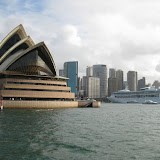Allright, here are some things I wanted on the record about my individual episodes:
Ep 2: "The Privacy of the Passengers": The "shrine" shown as I'm talking about shrines... isn't a shrine. It's a statue of Shivaji, the local war hero. You can find his likeness all over Maharashtra.
Ep 4: "They Paint the Streets":
-The food I was talking about is specifically the food we got at the hotel; People who come to India are a pretty self-selecting group. If they don't like Indian food in general, they don't come.
-As a rule, I asked for permission before turning the camera on people. Often people would ask me to film them and their friends and family when they saw I had a camera. That's where the footage of people staring at me comes form.
-See the shirt I'm wearing during the camel ride? Okay, now watch "The Varkari Guru" again. Look familiar? That's because these happened on the same night. The camel ride in this episode happened when I briefly stepped out of the drumming ceremony in the last episode to see what the parade noise outside was all about.
Ep 5: "Treehouse": Notice something funny about the edges of the shots in the forest of Periyar Wildlife Sanctuary? It's a plastic bag. It was raining for the first hour or so of our hike, so that was how I kept the camera safe and dry.
Ep 6: "What to Eat with Your Hands":
-First of all, yes I am eating my gulab jamun with a spoon after saying they eat with their hands here. Not everything is eaten by hand, and often people will use utensils to be polite. Us westerners often did it just because eating rice and liquids and tearing bread with one hand is harder than it looks...
-Second, people asked how people ate liquids with their hands. Generally what they would do would be to take some sort of roti (bread) and use it to get the solid pieces out (meat, veggies, paneer, etc.) and then soak up what's left with rice. Usually in a thali restaurant they will serve you roti first, then wait until you're done with that to give you the rice for that reason.
Ep 7: "Big Cat":
-Okay, I got up at 6 am to record this. I thought I could find privacy and quiet that way. You can see how well that worked out. Listen carefully, you can hear those car horns during the main body of the episode as well as the outtake bit, (thankfully the music covers them up some).
-It's worth saying that graffiti of sacred images is not generally a big concern among Indians, but I did spot a lot of graffiti in roman script in other parts of the temple, probably from foreign tourists That's why I was talking about putting the main images behind bars.
-Why did I go to the zoo? Well, I actually worked in the Woodland Park Zoo in Seattle over the summer; I kinda wanted to compare notes. Interesting experience overall. The "Please Don't Cross the Barricade, Survivors will be Prosecuted" sign is now my desktop photo on this computer.
Ep 8: "Namaste" (no accent on the e necessary, but it's passable as it's from a language that uses a different script).
-The temples date back to the 7th century CE, not BCE. That may be a one-letter difference, but it changes the date by about 1400 years. My mistake.
-The "Monkey Menace" sign was no joke; one of my friends got robbed by a monkey in Vijayanagara. Those guys will try to mug in packs given the chance. Do not show them food or anything flashy, they will try to take it.
-The Golgumbaz in Bijapur is not bigger than the Taj in Agra, it just has a bigger dome than the Taj does.
-Joel Shack was a shack that sold seafood and cocktails in Goa. I visited it and sought out the owner. Hilarity ensued.
That's about all! Any questions, comments or further corrections should be emailed to me at Joel1@nbcuni.com.








 Questions? Comments?
Questions? Comments?
No comments:
Post a Comment